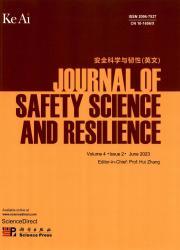Intelligent emergency assisted decision-making method based on standard digitalization: Hazardous chemical accidents in industrial parks
IF 3.4
Q1 PUBLIC, ENVIRONMENTAL & OCCUPATIONAL HEALTH
引用次数: 0
Abstract
Contemporary society is confronted with multifaceted challenges, and the intricate interplay of interconnected factors significantly complicates emergency response efforts. Current practices rely on quick decisions by domain experts; however, the limitations of individual expertise and the urgency of crises hinder both precision and standardization. To address these issues, we propose a novel approach: an intelligent method for emergency decision-making grounded in a standardized digital knowledge graph. First, our study examined the underlying theory of standardized digital transformation and event-chain evolution. This led to the construction of a knowledge graph encompassing standard emergency knowledge, as well as supplementary derivative data pertinent to event response. Second, through the application of semantic analysis and intention recognition of the decision target, coherent and interpretable query sentences for the decision system were crafted. These query sentences then served as a conduit for retrieving standard emergency knowledge relevant to the current emergency situation, as well as potential secondary disasters. The overarching goal is to provide emergency decision makers with effective support mechanisms that are both well informed and tailored to the specific demands of each situation.
基于标准数字化的工业园区危险化学品事故智能应急辅助决策方法
当代社会面临着多方面的挑战,相互关联的因素错综复杂的相互作用使应急响应工作大大复杂化。当前的实践依赖于领域专家的快速决策;然而,个人专业知识的局限性和危机的紧迫性阻碍了准确性和标准化。为了解决这些问题,我们提出了一种新颖的方法:一种基于标准化数字知识图的应急决策智能方法。首先,我们的研究考察了标准化数字化转型和事件链演化的基础理论。这导致构建了一个包含标准应急知识的知识图,以及与事件响应相关的补充衍生数据。其次,通过对决策目标的语义分析和意图识别,为决策系统构建连贯、可解释的查询语句。然后,这些查询语句作为检索与当前紧急情况以及潜在的次生灾害相关的标准应急知识的渠道。首要目标是向紧急情况决策者提供有效的支助机制,这些机制既了解情况,又适合每种情况的具体需求。
本文章由计算机程序翻译,如有差异,请以英文原文为准。
求助全文
约1分钟内获得全文
求助全文
来源期刊

安全科学与韧性(英文)
Management Science and Operations Research, Safety, Risk, Reliability and Quality, Safety Research
CiteScore
8.70
自引率
0.00%
发文量
0
审稿时长
72 days
 求助内容:
求助内容: 应助结果提醒方式:
应助结果提醒方式:


